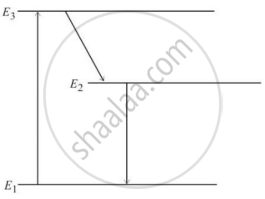Advertisements
Advertisements
प्रश्न
The stopping potential in a photoelectric experiment is linearly related to the inverse of the wavelength (1/λ) of the light falling on the cathode. The potential difference applied across an X-ray tube is linearly related to the inverse of the cutoff wavelength (1/λ) of the X-ray emitted. Show that the slopes of the lines in the two cases are equal and find its value.
(Use Planck constant h = 6.63 × 10-34 Js= 4.14 × 10-15 eVs, speed of light c = 3 × 108 m/s.)
उत्तर
V0 - Stopping Potential
K - Potential difference across X-ray tube
λ - Wavelength
λ - Cut difference Wavelength
`eV_0 = hf - hf_0`
`lambda = (hc)/(eV)`
`eV_0 = (hc)/lambda`
or ` Vlambda = (hc)/e`
or `V_0lambda = (hc)/e`
Here, the slopes are same.
i.e. V0λ = Vλ
`(hc)/e = (6.63 xx 10^-34 xx 3 xx 10^8)/(1.6 xx 10^-19)`
= `1.242 xx 10^-6 "Vm"`
APPEARS IN
संबंधित प्रश्न
How are infrared waves produced?
Name the phenomenon which shows the quantum nature of electromagnetic radiation.
Two waves A and B have wavelength 0.01 Å and 9000 Å respectively.
- Name the two waves.
- Compare the speeds of these waves when they travel in vacuum.
Name of physical quantity which remains same for microwaves of wavelength 1 mm and UV radiations of 1600 Å in vacuum.
Can X-rays be used for photoelectric effect?
Consider a photon of a continuous X-ray coming from a Coolidge tube. Its energy comes from
If the current in the circuit for heating the filament is increased, the cutoff wavelength
The Kα X-rays of aluminium (Z = 13) and zinc (Z = 30) have wavelengths 887 pm and 146 pm respectively. Use Moseley's law √v = a(Z − b) to find the wavelengths of the Kα X-ray of iron (Z = 26).
(Use Planck constant h = 6.63 × 10-34 Js= 4.14 × 10-15 eVs, speed of light c = 3 × 108 m/s.)
Name the scientist who discovered Infra-red waves
Name the radiation which can be detected by thermopile.
Choose the correct option.
The EM wave emitted by the Sun and responsible for heating the Earth’s atmosphere due to greenhouse effect is
Solve the numerical problem.
The speed of light is 3 × 108 m/s. Calculate the frequency of red light of a wavelength of 6.5 × 10−7 m.
Name the e.m. waves which are suitable for radar systems used in aircraft navigation. Write the range of frequency of these waves.
If the Earth did not have atmosphere, would its average surface temperature be higher or lower than what it is now? Explain.
A car is moving towards a high cliff. The car driver sounds a horn of frequency f. The reflected sound heard by the driver has a frequency 2f. If v be the velocity of sound, then the velocity of the car, in the same velocity units, will be:
The frequency of x-rays, y-rays and ultraviolet rays are respectively a, b and c. Then:-
Find the photon energy in units of ev for electromagnetic wave if waves length 40 m. Given h = 6.63 × 10–34 J.
A radio can tune to any station in the 7.5 mHz to 12 MHz band. What is corresponding wave length band.
What happens to the intensity of light from a bulb if the distance from the bulb is doubled? As a laser beam travels across the length of a room, its intensity essentially remains constant. What geometrical characteristic of LASER beam is responsible for the constant intensity which is missing in the case of light from the bulb?
In an atom X, electrons absorb the energy from an external source. This energy “excites” the electrons from a lower-energy level to a higher-energy level around the nucleus of the atom. When electrons return to the ground state, they emit photons.
The figure below is the energy level diagram of atom X with three energy levels, E1 = 0.00eV, E2 = 1.78eV and E3 = 2.95eV. The ground state is considered 0 eV for reference. The transition of electrons takes place between levels E1 and E2.

- What wavelength of radiation is needed to excite the atom to energy level E2 from E1?
- Suppose the external source has a power of 100 W. What would be the rate of photon emission?
